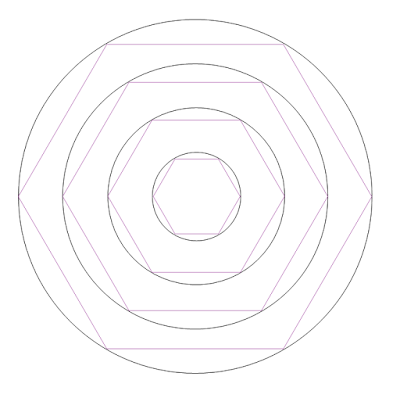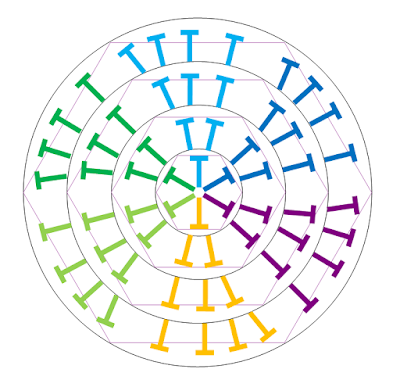R1: 6sc in magic ring (or chain 2 and 6sc into the 2nd loop) [6]
R2: Increase in each stitch (2sc in each sc from R1) [12]
R3: Sc, inc around [18]
R4: Sc, sc, inc around [24]
R5: Sc, sc, sc, inc around [30]
R6: Sc, sc, sc, sc, inc around [36]
You can see that each subsequent round has one more single crochet added on to each repeat. Another way to think about this is to imagine the circle you are building as a hexagon because you started with 6sc. Each round, you repeat each row's pattern 6 times to form the sides of a hexagon.
 |
| Each row can be thought of as a hexagon. |
This makes counting your stitches in each row easy. For row 1, you have 1 stitch in each side of your hexagon. In row 2, you have 2 stitches in each side. For example on row 6, you can count as you complete each side: 1, 2, 3, 4, 5&6, putting both the fifth and sixth stitches in the same place in the previous round.
Using that method, a quick way to remember the pattern is this:
R1: 1 sc on each side (6 repeats of 1)
R2: 2 sc on each side (6 repeats of 2)
R3: 3 sc on each side (6 repeats of 3)
R4: 4 sc on each side (6 repeats of 4)
R5: 5 sc on each side (6 repeats of 5)
R6: 6 sc on each side (6 repeats of 6)
 |
| Each color is one sixth of the circle and each row adds one more single crochet. |
There are two patterns for working the increases:
- Starting each round the same way (either with 1 single crochet or with the increase) will give you a more hexagonal looking finished project with a slight swirl.
- Alternating rounds by starting with a single crochet in one row and an increase in the next will produce a more rounded project. By staggering increases, they will not line up evenly and create angles in your work.
 |
| The shape of the project will differ depending on the placement of the increases. |
You can also work the joining of rounds using two methods. The first is to complete the final stitch of the round and slip stitch into the first stitch of that round. Then chain 1 and begin the next round. This will leave a visible seam in the work (which can be corrected with a special seamless join method) and will also leave the outside row more even if it is to be joined with other shapes. The second method is to crochet continuously around, ending each row by completing the final stitch and beginning the next row immediately in the first stitch of the previous round. This method leaves no seam but will look slightly uneven on the final round. Using a stitch marker is a good idea for both methods to distinguish the first stitch of each round.

Thanks for your explanation. I placed away so many doilies because they are no flats, trying to fix them first. It is a very clarifying explanation.
ReplyDelete